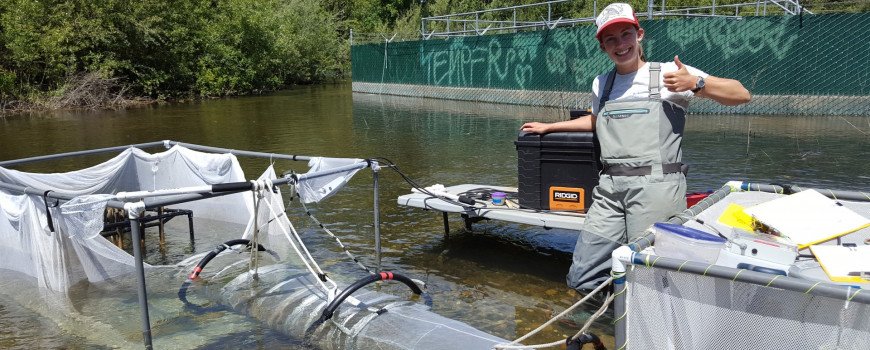Delta Science Fellowship 2020
Fellow: Megan Sabal, PhD Student, UC Santa Cruz
Research mentor: Eric Palkovacs, University of California, Santa Cruz
Community mentors: Steve Lindley, NOAA Southwest Fisheries Science Center
Why this research matters
Chinook salmon are an iconic part of California’s environment and heritage, and important both
economically and culturally. In the Sacramento River, the winter-run Chinook population is
endangered, and there is strong interest in restoring these populations. To do so, resource
managers need to better understand the pressures on wild populations. Predation by
nonnative predators affects survival of young salmon but may also affect the behavior of
salmon. Changes to salmon behavior also have costs but are not currently considered in
management. Managers need information on how predators affect juvenile salmon behavior,
how they might vary under different conditions, and how they scale up to affect populations.
Project
the Lower Mokelumne River California. The researchers combined experimental methods with modeling
techniques to examine how habitat and salmon origin (hatchery vs. wild) influenced salmon antipredator behavior, and how these context-dependent decisions scaled up to affect salmon populations.
Results
In this study, Delta Science Fellow Megan Sabal developed a new conceptual framework to understand
how directionally moving prey perceive predation risk and make economic decisions. This framework
provides a link to connect small-scale antipredator decisions to large-scale patterns, and fitness
consequences. Through a field experiment, Sabal found that hatchery salmon did not react to a model
predator, while wild salmon did. This has important implications for a potential mechanism for poor
hatchery salmon survival and a potential conservation strategy—predator conditioning in hatcheries.
In a second field experiment, Sabal found that Chinook salmon’s predation response depends on habitat, and that the fish exhibited a stronger, but slower, predation response in shady conditions compared to the sun. Preliminary results from a dynamic programming model found that salmon antipredator decisions during migration can scale up to affect ocean arrival timing, energetic condition, and adult salmon returns.
Management Applications
The experimental findings of this study provide important new information for resource managers looking for the most effective ways to increase salmon adult returns by considering predator effects to salmon behavior. The dynamic programming model, which incorporates salmon antipredator decisions, habitat, and salmon origin, will allow researchers to run scenarios with different management options to compare the potential impacts on salmon behavior, survival, and adult returns. This will allow managers to design restorations strategies that fit best for specific locations and stakeholders.
Sabal has presented this research to resource managers at both the NOAA Southwest Fisheries Science
Center and the State Water Contractors.
Select Publications and Presentations
and an experimental test with juvenile Chinook salmon. Journal of Animal Ecology.
https://doi.org/10.1111/1365-2656.13233
shift antipredator behavior in an unfamiliar migration corridor. Oecologia.
“An escape theory model for migrating prey and an experimental test in juvenile salmon.” Reno, NV.

